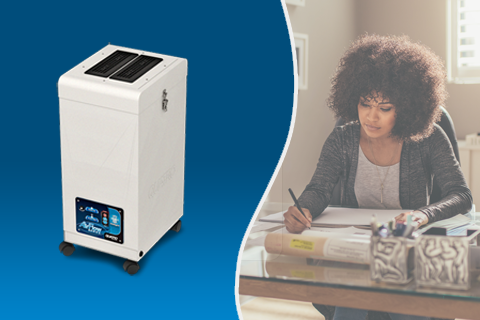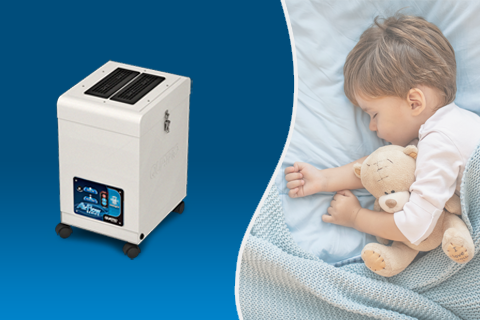Residential
Overview
 The average person spends as much as 87% of his life indoors, the majority of which is in their home. That number has only increased since the COVID pandemic as more adults began working remotely and schools switched to online learning.
The average person spends as much as 87% of his life indoors, the majority of which is in their home. That number has only increased since the COVID pandemic as more adults began working remotely and schools switched to online learning.
The place where we raise our kids and spend so much of our waking and sleeping hours, nowhere is the indoor air quality (IAQ) more important than in our homes. Yet the IAQ in most houses today falls well below standard. The World Health Organization (WHO) estimates that indoor air is 8 times more contaminated than outdoors, even in heavily polluted cities. That figure can be even higher in some buildings depending on the number of residents and the year of construction. As many newer homes are tightly built, they often trap toxins inside requiring better ventilation.
Air Quality Challenges
Many symptoms we normally associate with allergies such as sore throat, stuffy nose, and headaches are actually symptoms of poor indoor air quality. Long-term exposure to indoor air pollutants can lead to devastating health consequences including heart disease, chronic respiratory illnesses, and even cancer.
Some of the most common toxins contributing to poor IAQ in homes are:
- Mold
- Volatile Organic Compounds
- Outdoor Air Pollution
- High Carbon Dioxide Levels
- Indoor Particulate and Dust
Mold
If your home has water damage, a leaky roof or faulty plumbing, then you are at risk of mold contamination. Mold has spores that may contain mycotoxins, which could be poisonous. These spores can circulate and pollute indoor air leading to a number of health concerns such as:
- Respiratory Issues
- Coughing
- Wheezing
- Allergic Rhinitis
- Headache
- Dizziness
- Poor concentration
- Nose Bleeds
- Rashes
Bathtubs, showers, condensation on windows and water spills are all places where moisture can build up and mold can take hold.
Volatile Organic Compounds (VOCs)
Volatile Organic Compounds (VOCs) are toxic gasses that can originate from a number of different sources. Common VOCs include formaldehyde, fire retardants, benzene and acetone. They are also produced by the off gassing of common household items such as:
- Furniture
- Carpeting
- Mattresses
- Wall hangings
- Paints
- Glues
- Cleaning Agents and Disinfectants
- Air Fresheners
- Candles
- Personal Care Products
Printers also can release VOCs along with nitrogen dioxide and ozone. Newly constructed homes in particular expose families to even higher levels of these harmful compounds.
Inhaling VOCs can cause fatigue, irritability, brain fog and eye, nose and throat irritation. High levels of exposure are far more dangerous and can lead to:
- Skin Irritation
- Neurotoxic effects
- Liver toxicity
- Cancer
Outdoor Air Pollution
Opening windows and doors in warm weather can help bring in fresh air but with it comes outdoor pollution. Car exhaust, carbon monoxide gas and fumes are all toxins that can infiltrate and contaminate indoor air. If not adequately ventilated and filtered, these pollutants can build up in a home contributing to poor IAQ. Houses located in a polluted city or near a highway or industrial plant are particularly at risk.
Carbon Dioxide Levels
High carbon dioxide levels can also negatively impact IAQ. Indoor spaces with elevated CO2 have been shown to adversely affect people’s health. If allowed to accumulate, CO2 can cause drowsiness, fatigue, headaches, dizziness and respiratory problems. Children’s health can also suffer, contributing to more school absences and reduced academic performance.
The American Society of Heating, Refrigerating, Air-Conditioning Engineers (ASHRAE) states that CO2 concentrations should be lower than 1000 parts per million (ppm) to maintain good air quality. Installing a system that filters and ventilates the air is essential to keep CO2 levels down.
The American National Standards Institute (ANSI)/ American Society of Heating, Refrigerating and Air Conditioning Engineers (ASHRAE) have guidelines for ventilation system design for acceptable IAQ. Standards 62.1 and 62.2 outline minimum ventilation rates and other measures businesses can take to curtail the adverse health effects of poor indoor air quality.
Indoor Particulate and Dust
Particles are solid or liquid substances that include dust, dust mites, pollen, sulfates, metals and dirt. Light enough to suspend in the air, the largest particles can be seen with the naked eye in a ray of sunlight. It’s the smaller ones that you can’t see that pose the biggest inhalation hazard, as they have the ability to pass right through the nasal cavities and into the lungs.
Some particulate matter is brought in from outdoors but some originates from indoor activities. Cooking produces particulate matter as do printers and some heating appliances like gas or oil furnaces. Inhaling particulates and dust can cause:
- Eye, Nose and Throat Irritation
- Respiratory Infections
- Bronchitis
- Asthma
- Lung Cancer
If you have a pet, then your indoor air is also likely contaminated with pet dander, yet another particulate. Consisting of microscopic flakes of skin shed by household animals, dander can be a problem even for owners with hairless breeds. While many people may not react to pet dander, for allergy sufferers, the effects are acute. Coughing, sneezing, chest tightness and watery eyes are all reactions to dander.
Installation of a proper air purifier with HEPA filtration helps to minimize exposure to these indoor contaminants.
Solutions for Residential Environments
To keep your family happy and healthy, addressing IAQ is essential. A high quality HEPA air purifier is an effective way to reduce indoor pollution and create a healthier home environment.

AF 400
HEPA Air Purifier
Compact and powerful, the AF400 is ideal for localized chemical, odor and particle removal. Effective for virus control. 300 nominal CFM.
Get Product Details
AF 400M
HEPA Air Purifier
A portable air purifier for localized chemical, odor and particle removal. Effective for virus control. 300 nominal CFM.
Get Product Details